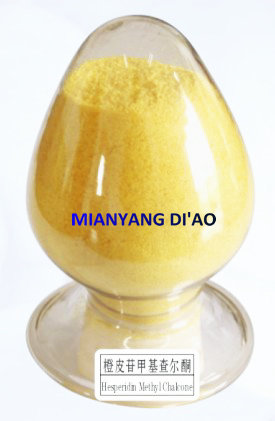Products
Hesperidin Methyl Chalcone


Hesperidin Methyl Chalcone is a derivative of the flavonoid hesperidin and is found in citrus fruits like oranges and grapefruit and is often used to reduce dark circles under the eyes. According to CosmeticsCop.com, one study documented that it lowers the filtration rate of capillaries, and less blood flowing though capillaries close to the surface of the skin potentially means less dark bluish discoloration under the eyes. It’s also thought to prevent leaking from the veins below the eyes, also preventing the dark blue look from blood leaking below the surface of the skin. It is also thought to support and protect the integrity of the vascular system, specifically the capillaries and veins. Hesperidin Methyl Chalcone has been shown to help strengthen capillaries by increasing capillary resistance, decreasing capillary permeability, and allowing vessels to dilate more easily.
Behind the scientific name hesperidin methyl chalcone lies a powerful active principle. In May, we reported on its natural benefits for the cardiovascular system. In fact, its therapeutic potential has been shown to be much more extensive. Studies conducted over recent years suggest that Hesperidin Methyl Chalcone offers benefits for the prevention and treatment of a number of health problems. Read on to find out more about the protective effects.
Protective effects for maintaining cardiovascular health
To recap, our previous article on Hesperidin Methyl Chalcone focused on its cardio-protective effects. A study published in The Journal of Clinical Endocrinology & Metabolism1 had confirmed the compound’s vasodilatory action, showing that the activity of hesperidin methyl chalcone helped prevent certain cardiovascular problems such as hypertension. In another study, published in the specialist journal Experimental and Toxicologic Pathology2, Hesperidin Methyl Chalcone had been shown to have lipid-lowering effects and thus improve the lipid profile. Finally, several studies had demonstrated its antioxidant potency and cardio-protective potential3.
Photo-protective action for fighting the effects of UVB radiation
In addition to its benefits for cardiovascular health, it has also been studied for its antioxidant power and ability to combat the harmful effects of ultraviolet radiation. Scientists evaluated this photo-protective activity by administering hesperidin methyl chalcone to UVB-irradiated mice. Published in the Journal of Photochemistry and Photobiology B: Biology4, the results of this study revealed a number of beneficial effects. The hesperidin methyl chalcone treatment was found to inhibit several processes linked to UVB exposure: skin oedema, neutrophil recruitment, and matrix metalloproteinase-9 activity. The researchers also found it had a powerful antioxidant effect which reduced free radical generation. Their results suggest this compound could also offer anti-inflammatory effects for inhibiting pro-inflammatory mediator synthesis.
Anti-inflammatory and analgesic properties
It’s anti-inflammatory activity, mentioned above, together with its analgesic potential, was demonstrated in another study conducted on mice. Published in the journal Chemico-Biological Interactions5, this research confirmed the potential of hesperidin methyl chalcone to reduce inflammatory pain and fight inflammatory reactions. Hesperidin Methyl Chalcone also shed light on its mechanism of action, suggesting that it acts on specific cell receptors called TRPV1. These are known to affect pain mechanisms, oxidative stress, production of inflammatory cytokines and activity of the transcription factor NF-kB. This research also found an absence of side-effects from the use of it.
Di’ao supply high quality HMC.
